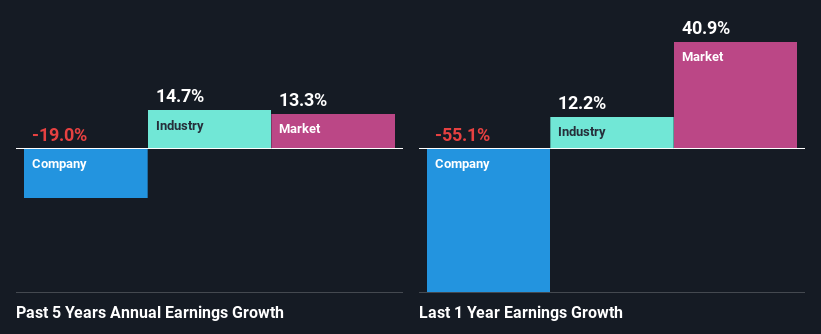Royalty Pharma plc (NASDAQ:RPRX) Stock's Been Sliding But Fundamentals Look Decent: Will The Market Correct The Share Price In The Future?
It is hard to get excited after looking at Royalty Pharma's (NASDAQ:RPRX) recent performance, when its stock has declined 10% over the past week. But if you pay close attention, you might find that its key financial indicators look quite decent, which could mean that the stock could potentially rise in the long-term given how markets usually reward more resilient long-term fundamentals. Specifically, we decided to study Royalty Pharma's ROE in this article.
Return on Equity or ROE is a test of how effectively a company is growing its value and managing investors’ money. Simply put, it is used to assess the profitability of a company in relation to its equity capital.
View our latest analysis for Royalty Pharma
How Is ROE Calculated?
The formula for return on equity is:
Return on Equity = Net Profit (from continuing operations) ÷ Shareholders' Equity
So, based on the above formula, the ROE for Royalty Pharma is:
15% = US$1.6b ÷ US$10b (Based on the trailing twelve months to September 2021).
The 'return' is the income the business earned over the last year. So, this means that for every $1 of its shareholder's investments, the company generates a profit of $0.15.
What Is The Relationship Between ROE And Earnings Growth?
So far, we've learned that ROE is a measure of a company's profitability. Depending on how much of these profits the company reinvests or "retains", and how effectively it does so, we are then able to assess a company’s earnings growth potential. Generally speaking, other things being equal, firms with a high return on equity and profit retention, have a higher growth rate than firms that don’t share these attributes.
Royalty Pharma's Earnings Growth And 15% ROE
At first glance, Royalty Pharma seems to have a decent ROE. Be that as it may, the company's ROE is still quite lower than the industry average of 19%. Further research shows that Royalty Pharma's net income has shrunk at a rate of 19% over the last five years. Not to forget, the company does have a high ROE to begin with, just that it is lower than the industry average. So there might be other reasons for the earnings to shrink. These include low earnings retention or poor allocation of capital.
However, when we compared Royalty Pharma's growth with the industry we found that while the company's earnings have been shrinking, the industry has seen an earnings growth of 15% in the same period. This is quite worrisome.
Earnings growth is an important metric to consider when valuing a stock. It’s important for an investor to know whether the market has priced in the company's expected earnings growth (or decline). By doing so, they will have an idea if the stock is headed into clear blue waters or if swampy waters await. If you're wondering about Royalty Pharma's's valuation, check out this gauge of its price-to-earnings ratio, as compared to its industry.
Is Royalty Pharma Making Efficient Use Of Its Profits?
Looking at its three-year median payout ratio of 29% (or a retention ratio of 71%) which is pretty normal, Royalty Pharma's declining earnings is rather baffling as one would expect to see a fair bit of growth when a company is retaining a good portion of its profits. So there might be other factors at play here which could potentially be hampering growth. For example, the business has faced some headwinds.
Only recently, Royalty Pharma stated paying a dividend. This likely means that the management might have concluded that its shareholders have a strong preference for dividends. Upon studying the latest analysts' consensus data, we found that the company's future payout ratio is expected to drop to 21% over the next three years. As a result, the expected drop in Royalty Pharma's payout ratio explains the anticipated rise in the company's future ROE to 25%, over the same period.
Conclusion
On the whole, we do feel that Royalty Pharma has some positive attributes. Yet, the low earnings growth is a bit concerning, especially given that the company has a respectable rate of return and is reinvesting a huge portion of its profits. By the looks of it, there could be some other factors, not necessarily in control of the business, that's preventing growth. That being so, the latest industry analyst forecasts show that the analysts are expecting to see a huge improvement in the company's earnings growth rate. To know more about the company's future earnings growth forecasts take a look at this free report on analyst forecasts for the company to find out more.
Have feedback on this article? Concerned about the content? Get in touch with us directly. Alternatively, email editorial-team (at) simplywallst.com.
This article by Simply Wall St is general in nature. We provide commentary based on historical data and analyst forecasts only using an unbiased methodology and our articles are not intended to be financial advice. It does not constitute a recommendation to buy or sell any stock, and does not take account of your objectives, or your financial situation. We aim to bring you long-term focused analysis driven by fundamental data. Note that our analysis may not factor in the latest price-sensitive company announcements or qualitative material. Simply Wall St has no position in any stocks mentioned.

 Yahoo Finance
Yahoo Finance 
